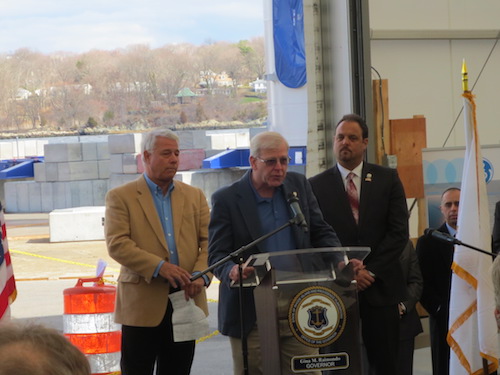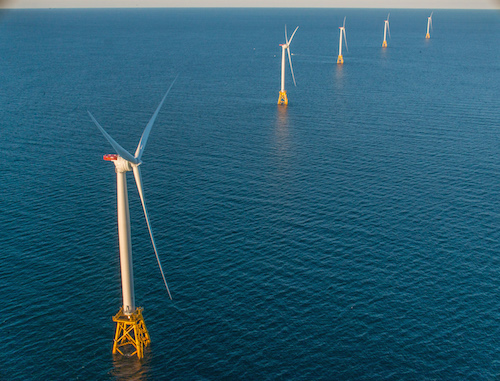Business Manager Michael K. Daley
and everyone with Providence, R.I., Local 99
had reason to celebrate when the first offshore wind farm in U.S. waters became fully operational in mid-December.

|
| Providence, R.I., Local 99 Business Manager Michael K. Daley speaks during a news conference in the spring of 2016 at the Port of Providence, where Local 99 members helped build what became the Block Island Wind Farm.
|
“It was awesome,” Daley said. “It was a feeling of so much pride that the IBEW had been a part of this.”
There could be even better news on the horizon. Deepwater Wind’s Block Island Wind Farm -- which Local 99 not only helped build, but helped get off the ground because of its ongoing dialogue with Rhode Island officials – could lead to more work for IBEW members.
Hopefully, a lot more.
“The real prize was not the five turbines,” said Paul MacDonald, Local 99’s legislative director. “I look at that as a demonstration project. The real prize is what’s going to come.”
About 50 Local 99 members were involved in the construction, most at a temporary mainland facility at the Port of Providence. Block Island is 13 miles south of the Rhode Island coast.
The project is tiny compared to the massive offshore wind farms that have sprouted up around the world during the last two decades, particularly in European coastal areas. It has just five turbines.
It showed, however, they have a place in the United States. MacDonald said they will hold down energy costs, which could also make it more attractive to businesses.
“It has to come because the cost of energy is getting out of hand,” he said. “In the Northeast, it’s getting so expensive that it stymies business. People are thinking of ways to stop that.”
“This [the Block Island project] is a demonstration that it’s feasible and that it works,” he added. “When we have these things with 200, 300 or 500 turbines, that’s when you’re really going to see a lot of jobs.”
Deepwater Wind has received permission for another project, this one in federally-controlled waters. Called Deepwater One, it will be about 30 miles southeast of the eastern edge of New York’s Long Island. Company officials hope to start work in 2019 and the first phase is expected to provide energy for 50,000 homes when it is finished in 2022.
The project will be within Local 99’s jurisdiction. Daley noted the turbines for the Block Island project were largely constructed overseas before being assembled by Local 99 members at the Port of Providence. For a larger project, it might be more economical for the turbines to be built domestically – more potential work for Local 99 members.
The first phase of the Deepwater One project calls for just 15 turbines, but it is eventually expected to have about 200.
“We’re hoping if that goes, it will spur more work in Rhode Island and southeast Massachusetts in building the turbines over here on the mainland,” Daley said.
Local 99 long was active in the push toward Rhode Island becoming the first state to approve and have constructed an off-shore wind farm. MacDonald remembers first approaching then-Gov. Don Carcieri about the possibility nearly 10 years ago. Two governors later, and after constant lobbying of local and state legislators, construction started in 2015 and Block Island Wind Farm was operational a little more than a year later.
Other groups joined in the campaign, including the state’s other trade unions along with industry and environmental groups. MacDonald said building that coalition was essential, but the IBEW can take pride in that it saw the potential before most others and stayed with it.
He complimented Local 99 members for contacting legislators, attending meetings and even handing out lapel pins with a miniature wind turbine.
“In Texas, they say drill baby drill,” said MacDonald, whose grandson, a Local 99 apprentice, worked on the Block Island project. “In Rhode Island, we say turn baby turn.”
“We’ve got an awful lot to be proud of,” he added. “If it wasn’t for the IBEW, I don’t think we would have seen a blade turn. We stayed with it. Most everyone up here would admit that we’re the godfather of wind.”
Daley said Deepwater Wind officials appreciate the work done by Local 99 behind the scenes. They respect the work done on the turbines by Local 99 members and signatory contractors.
That should pay off in the future, he said.

|
An aerial view of the Block Island Wind Farm.
Photo provided by Deepwater Wind.
|
“They know that we were critical,” Daley said. “We were there and we were supporting them throughout the regulatory process. Without us, this may not have happened.”
Rhode Island likely will be a leader in offshore wind development, which also should be good news for Local 99 and its members. Gov. Gina Raimondo recently was named chairman of the Governors Wind and Solar Energy Coalition,, a bipartisan group of governors interested in promoting wind energy. She and other state legislators have said repeatedly how important its development is to the state’s future.
“It means a cleaner source of energy, a lower cost of energy, a diversified energy supply,” Raimondo told Providence television station WPRI. “It means a lot of jobs.”
“This is the way to rebuild our economy,” she added. “We cannot bring back old-fashioned manufacturing.”
Deepwater Wind Chief Executive Officer Jeff Grybowski told the Washington Post he doesn’t expect incoming President Donald Trump’s administration to have much impact on the growth of wind energy,, adding that local markets have created more of a demand than national policy, even though outgoing President Barack Obama’s administration was a strong proponent of it.
“Taking offshore wind from a theoretical thing to a reality is what Block Island has done,” Grybowski said. “As the first project to cross the finish line, it’s really proven that offshore wind can be done in the United States.”
Deepwater Wind is asking Maryland officials for approval to build a wind farm in the Atlantic Ocean off the coast of Ocean City. It also is working with the utility PSEC to build a windfarm off the coast of Cape May, N.J.
Other companies are expected to enter the offshore wind farm business in the United States as well. The federal government has issued 11 leases for wind farms up and down the East Coast between Massachusetts and Virginia.
All that means additional work for other IBEW locals and trade unions, so Daley suggested that other union leaders looking to use the growth of industry to find work for members work closely with companies committed to it – like Local 99 did with Deepwater Wind – and realize it’s going to be a long process, he said.
“You have to be patient and you have to persevere,” he said. “There are definitely going to be naysayers. There will be people that don’t want it for various reasons, but this is going to happen. It makes too much sense.”
Home page photo credit: Photo by Deepwater Wind.